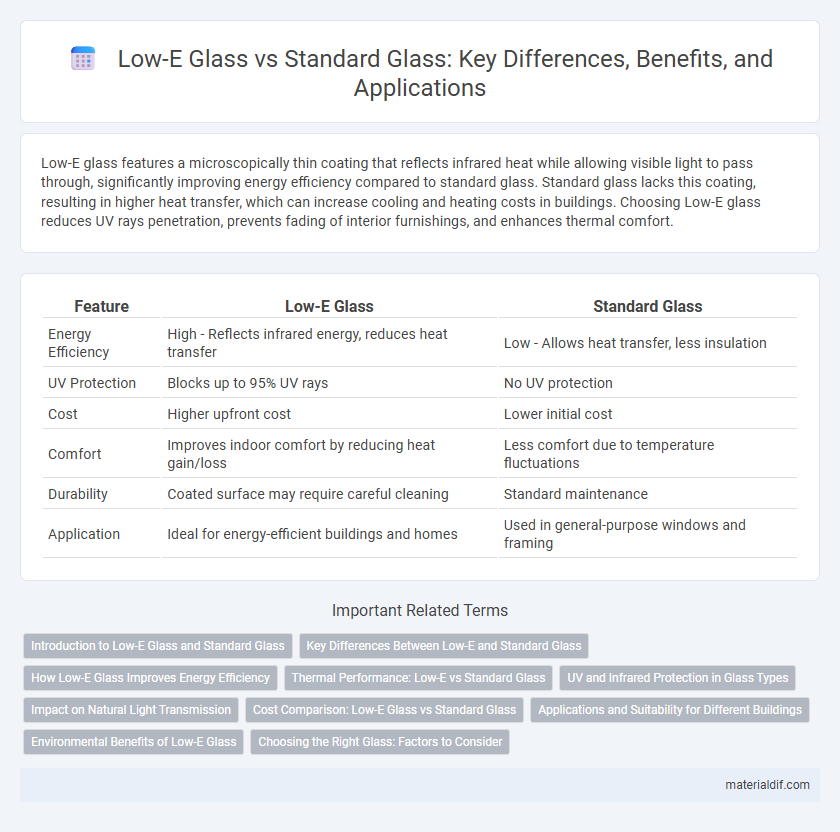Low-E glass features a microscopically thin coating that reflects infrared heat while allowing visible light to pass through, significantly improving energy efficiency compared to standard glass. Standard glass lacks this coating, resulting in higher heat transfer, which can increase cooling and heating costs in buildings. Choosing Low-E glass reduces UV rays penetration, prevents fading of interior furnishings, and enhances thermal comfort.
Table of Comparison
| Feature | Low-E Glass | Standard Glass |
|---|---|---|
| Energy Efficiency | High - Reflects infrared energy, reduces heat transfer | Low - Allows heat transfer, less insulation |
| UV Protection | Blocks up to 95% UV rays | No UV protection |
| Cost | Higher upfront cost | Lower initial cost |
| Comfort | Improves indoor comfort by reducing heat gain/loss | Less comfort due to temperature fluctuations |
| Durability | Coated surface may require careful cleaning | Standard maintenance |
| Application | Ideal for energy-efficient buildings and homes | Used in general-purpose windows and framing |
Introduction to Low-E Glass and Standard Glass
Low-E glass features a microscopically thin coating that reflects infrared energy while allowing visible light to pass through, improving thermal insulation compared to standard glass, which lacks this specialized coating. Standard glass transmits heat and UV rays more freely, leading to greater energy loss and potential interior fading. The advanced design of Low-E glass enhances energy efficiency in buildings by reducing heat transfer and maintaining indoor comfort.
Key Differences Between Low-E and Standard Glass
Low-E glass features a microscopically thin, transparent coating that reflects infrared energy, improving energy efficiency by minimizing heat transfer compared to standard glass. Standard glass lacks this coating, resulting in higher heat gain in summer and greater heat loss in winter. Low-E glass also enhances UV protection, reducing fading of interior furnishings, whereas standard glass allows more ultraviolet rays to pass through.
How Low-E Glass Improves Energy Efficiency
Low-E glass features a microscopically thin coating that reflects infrared heat while allowing visible light to pass through, significantly reducing heat loss during winter and heat gain in summer. This energy-efficient property minimizes reliance on heating and cooling systems, leading to lower utility bills. Compared to standard glass, Low-E glass enhances thermal insulation and optimizes indoor comfort by maintaining consistent indoor temperatures.
Thermal Performance: Low-E vs Standard Glass
Low-E glass significantly enhances thermal performance by reflecting infrared heat, reducing heat loss in winter and heat gain in summer compared to standard glass. This advanced coating minimizes energy consumption for heating and cooling, maintaining more consistent indoor temperatures. Standard glass lacks this infrared reflectivity, resulting in higher energy transfer and less efficient temperature regulation.
UV and Infrared Protection in Glass Types
Low-E glass significantly outperforms standard glass in blocking ultraviolet (UV) rays and infrared (IR) radiation, reducing UV transmission by up to 99% and helping maintain indoor temperature by reflecting IR heat. This advanced coating technology minimizes harmful UV exposure, preventing interior fading and skin damage, while boosting energy efficiency through superior thermal insulation. In contrast, standard glass lacks this specialized coating, allowing higher UV and IR passage, leading to increased heat gain and reduced protection against UV-induced deterioration.
Impact on Natural Light Transmission
Low-E glass features a microscopically thin coating that selectively filters ultraviolet and infrared light while allowing most visible light to pass through, resulting in higher natural light transmission compared to standard glass. Standard glass transmits a broader spectrum of light but allows more heat and UV radiation to enter, potentially causing glare and fading of interior materials. Low-E glass optimizes natural light by enhancing clarity and reducing energy loss, making it ideal for energy-efficient buildings.
Cost Comparison: Low-E Glass vs Standard Glass
Low-E glass typically costs 10-15% more than standard glass due to its advanced coating technology that enhances energy efficiency by reflecting infrared light while allowing visible light to pass through. Although the upfront investment is higher, Low-E glass reduces heating and cooling costs by up to 30%, providing long-term savings on energy bills that standard glass cannot match. The incremental price difference varies depending on factors such as glass thickness, coating quality, and installation complexity.
Applications and Suitability for Different Buildings
Low-E glass is ideal for energy-efficient buildings such as office complexes, green commercial spaces, and residential homes aiming to reduce heating and cooling costs, due to its advanced thermal insulation properties and ability to block ultraviolet rays. Standard glass is more suitable for applications where cost is a primary concern and thermal performance is less critical, such as in interior partitions or decorative facades. Buildings in extreme climates benefit significantly from Low-E glass, whereas structures in moderate climates may effectively use standard glass without major energy efficiency drawbacks.
Environmental Benefits of Low-E Glass
Low-E glass significantly reduces energy consumption by minimizing heat transfer, which lowers heating and cooling demands in buildings. Its advanced coating reflects infrared energy while allowing natural light, leading to decreased greenhouse gas emissions and enhanced sustainability. Compared to standard glass, Low-E glass contributes to improved thermal insulation, reducing reliance on fossil fuels and promoting eco-friendly construction.
Choosing the Right Glass: Factors to Consider
Low-E glass provides superior energy efficiency by blocking infrared light while allowing natural daylight, reducing heating and cooling costs compared to standard glass. Factors to consider include climate, as Low-E glass performs better in extreme temperatures, and budget, since it carries a higher upfront cost but yields long-term savings. Additionally, evaluating solar heat gain coefficient (SHGC) and visible transmittance (VT) helps determine the optimal balance between insulation and natural light for your specific needs.
Low-E glass vs Standard glass Infographic

 materialdif.com
materialdif.com